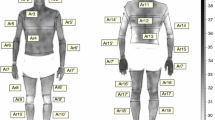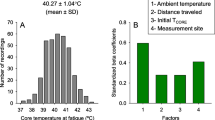Abstract
In 40 experiments on seven goats head and trunk temperatures were altered independently of each other and the effects on exercise performance on a treadmill (speed: 3 km/h, slope: 16%–20%) were observed. Brain temperature between 38.5°C and 42.0°C and trunk temperature between 39°C and 43.5°C did not reduce exercise performance or running time. Blood lactate concentration increased with rising brain and trunk temperatures, but did not exceed 13.1 mmol/l−1. Blood pressure and heart rate did not show any dependence on brain or trunk temperatures. Brain temperature between 42.0°C and 42.9°C shortened running time in 3 out of 12 experiments and reduced performance during shortlasting upward deviations of temperature. This suggests that in this species, the thermal safety limit to exercise is very close to that range of temperature which is likely to induce heat stroke.
Similar content being viewed by others
References
Adolph EF (1947) Tolerance to heat and dehydration in several species of mammals. Am J Physiol 151:564–575
Bell AW, Hales JRS, King RB, Fawcett AA (1983) Influence of heat stress on exercise-induced changes in regional blood flow in sheep. J Appl Physiol 55:1916–1923
Bligh J (1966) The thermosensitivity of the hypothalamus and thermoregulation in mammals. Biol Rev 41:317–367
Bowler K, Tirri R (1974) The temperature characteristics of synaptic membrane ATPase from immature and adult rat brain. J Neurochem 23:611–613
Burger FJ, Fuhrman FA (1964) Evidence of injury by heat in mammalian tissues. Am J Physiol 206:1057–1064
Caputa M (1980) Selective brain cooling: an important component of thermal physiology. In: Proceedings of the satellite symposium on thermal physiology. Pergamon Press, Pecs, pp 183–192
Caputa M, Kadziela W, Narebski J (1983) Cerebral temperature regulation in resting and running guinea-pigs (Cavia porcellus). J Therm Biol 8:265–273
Carithers RW, Seagrave RC (1976) Canine hyperthermia with cerebral protection. J Appl Physiol 40:543–548
Chesy G, Caputa M, Kadziela W, Lachowski W, Kozak W (1980) Exercise induced selective brain cooling in the ox. In: Proceedings of the satellite symposium on thermal physiology. Pergamon Press, Pecs, pp 193–195
Cooper KE, Kenyon JR (1957) A comparison of temperatures measured in the rectum, oesophagus, and on the surface of the aorta during hypothermia in man. Br J Surg 44:616–619
Feistkorn G (1984) Effects of body temperature on lactate concentration in muscle and plasma of exercising goats. Pflügers Arch Suppl 402:R49
Feistkorn G, Nagel A, Jessen C (1984) Circulation and acidbase balance in exercising goats at different body temperatures. J Appl Physiol Resp Environ Exercise Physiol 57:1655–1661
Fruth JM, Gisolfi CV (1983) Work-heat tolerance in endurancetrained rats. J Appl Physiol Resp Environ Exercise Physiol 54:249–253
Gwozdz B, Dyduch A, Grzybek H, Panz B (1978) Structural changes in brain mitochondria of mice subjected to hyperthermia. Exp Pathol 15:124–126
Gwozdz B, Krause M, Dyduch A (1970) Investigations on oxydative phosphorylation in the brain tissue of animals subjected to high temperature. Acta Physiol Pol 21:239–245
Heikkila JJ, Brown JR (1979) Hyperthermia and disaggregation of brain polysomes induced by bacterial pyrogen. Life Sci 25: 347–352
Jessen C (1981) Independent clamps of peripheral and central temperatures and their effects on heat production in the goat. J Physiol (Lond) 311:11–22
Jessen C (1984) Hyperthermia as a limit to exercise. In: Garlick DG, Korner PJ (eds) Frontiers in physiological research. Canberra, Australian Academy of Sciences
Jessen C, Feistkorn G (1984) Some characteristics of core temperature signals in the conscious goat. Am J Physiol 247:R456-R464
Khogali M, Elkhatib G, Attia M, Mustafa MKF, Gumaa K, El-Din AN, Al-Adnani MS (1983) Induced heat stroke: a model in sheep. In: Heat stroke and temperature regulation. Academic Press, Sydney, pp 253–261
Kozlowski S, Brzezinska Z, Kruk B, Kaciuba-Uscilko H, Greenleaf JE, Nazar K (1985) Exercise hyperthermia as a factor limiting physical performance in dogs: temperature effect on muscle metabolism. J Appl Physiol, in press
McDougall JD, Reddan WG, Layton CR, Dempsey JA (1974) Effects of metabolic hyperthermia on performance during heavy prolonged exercise. J Appl Physiol 36:538–544
Malamud N, Haymaker W, Custer RP (1946) Heat stroke, a clinicopathologic study of 125 fatal cases. Milit Surg 99:397–449
Mehta AC, Baker RN (1970) Persistent neurological deficits in heat stroke. Neurology 20:336–340
Millan N, Murdock LL, Bleier R, Siegel FL (1979) Effects of acute hyperthermia on polyribosomes, in vivo protein synthesis and ornithine decarboxylase activity in the neonatal rat brain. J Neurochem 32:311–317
Murdock LL, Berlow S, Colwell RE, Siegel FL (1978) The effects of hyperthermia on polyribosomes and amino acid levels in infant rat brain. Neuroscience 3:349–357
Schmidt V, Brueck K (1981) Effect of a precooling maneuver on body temperature and exercise performance. J Appl Physiol Resp Environ Exercise Physiol 50:772–778
Taylor CR (1970) Dehydration and heat: effects on temperature regulation of East African ungulates. Am J Physiol 219:1136–1138
Taylor CR (1977) Exercise and environmental heat loads: different mechanisms for solving different problems? In: Robertshaw D (ed) Environmental physiology II. Int Rev Physiol, vol 15, University Park Press, Baltimore, pp 119–146
Taylor CR, Lyman CP (1972) Heat storage in running antelopes: independence of brain and body temperatures. Am J Physiol 222:114–117
Taylor CR, Rowntree VJ (1973) Temperature regulation and heat balance in running cheetahs: a strategy for sprinters? Am J Physiol 224:848–851
Young DR, Mosher R, Erve P, Spector H (1959) Body temperature and heat exchange during treadmill running in dogs. J Appl Physiol 14:839–843
Author information
Authors and Affiliations
Rights and permissions
About this article
Cite this article
Caputa, M., Feistkorn, G. & Jessen, C. Effects of brain and trunk temperatures on exercise performance in goats. Pflugers Arch. 406, 184–189 (1986). https://doi.org/10.1007/BF00586681
Received:
Issue Date:
DOI: https://doi.org/10.1007/BF00586681




